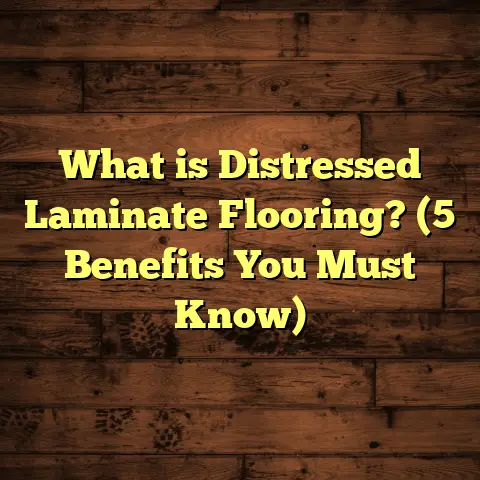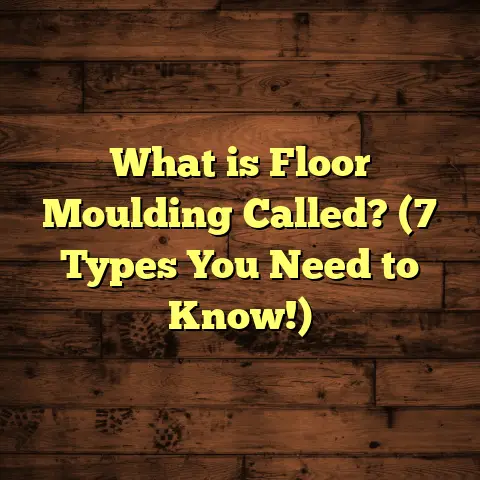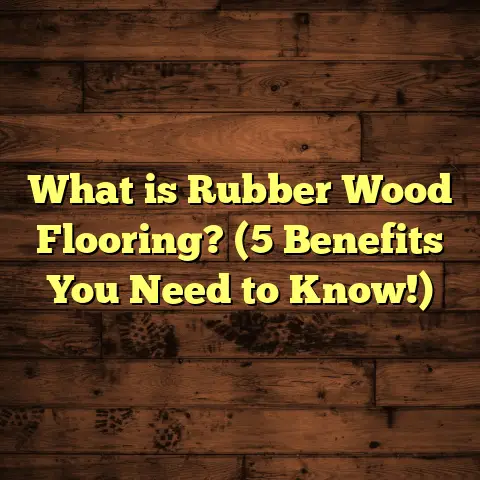What is Resilient Flooring Made Of? (5 Key Materials Explained)
Upgrading your home’s flooring can completely change the feel of a space. I’ve seen it firsthand — a fresh floor can brighten rooms, add warmth, and even boost your home’s value. Over the years, I’ve worked on many flooring projects, and one type that keeps popping up is resilient flooring. You might have heard the term but wondered, “What exactly is resilient flooring made of?” Let me walk you through it from my experience and share some insights that will help you understand this versatile option better.
What Is Resilient Flooring?
Resilient flooring is a category of floor coverings designed to be flexible and durable. It typically has some degree of “give” underfoot, making it comfortable to walk on and resistant to dents or scratches. This flexibility combined with toughness is why it’s so popular in homes, offices, and commercial spaces where foot traffic is high.
Unlike hardwood or tile, resilient floors often come in sheets, tiles, or planks that are easier to install and maintain. But what really sets resilient flooring apart is its material makeup — which gives it those unique properties.
Now, let’s get into the five key materials that make up resilient flooring. Knowing these will help you decide if this flooring suits your needs.
1. Vinyl: The Workhorse of Resilient Flooring
Vinyl is probably the most common material used in resilient flooring. It’s made primarily from polyvinyl chloride (PVC), a synthetic plastic polymer.
Why vinyl?
When I first started installing floors, vinyl was everywhere because it’s waterproof, affordable, and comes in tons of styles — from wood-look planks to bold patterns. It’s also easy to clean, which makes it perfect for kitchens and bathrooms.
How vinyl is made:
Vinyl flooring typically consists of multiple layers:
- A wear layer on top protects against scratches and stains.
- A design layer underneath gives vinyl its color and pattern.
- A core layer provides stability.
- And finally, a backing layer adds support and sometimes cushioning.
The thickness of these layers varies depending on the quality and price. For instance, commercial vinyl floors have thicker wear layers for heavy use.
Data point:
According to the Freedonia Group report (2023), vinyl flooring accounts for over 40% of the resilient flooring market in North America. Its popularity is driven by cost-effectiveness and durability.
My experience:
I remember a client who was worried about spills in their laundry room. Vinyl was the perfect fit — water didn’t seep through, and it was simple to mop up. Plus, the installation was quick, which saved them time and money.
Types of Vinyl Flooring
Vinyl flooring isn’t just one thing—there are several types you might come across:
- Sheet Vinyl: Comes in large rolls, great for covering big areas without seams.
- Vinyl Tiles: Square pieces that look like ceramic or stone tiles.
- Luxury Vinyl Planks (LVP): Designed to mimic hardwood planks with realistic textures.
- Luxury Vinyl Tiles (LVT): Mimic natural stone or tile looks with high durability.
Each type has its own advantages depending on where you’re installing it.
Installation Tips
I’ve found that vinyl installation goes smoothly when the subfloor is clean and level. Any bumps or debris can telegraph through thin vinyl sheets causing visible imperfections. For DIYers, peel-and-stick vinyl tiles offer an easier route but aren’t as durable as glued-down options.
2. Linoleum: The Natural Alternative
Linoleum often gets confused with vinyl but is quite different.
What is linoleum made of?
It’s a natural product made from oxidized linseed oil mixed with wood flour, cork dust, tree resins, and pigments — all pressed onto a jute backing.
Why choose linoleum?
Linoleum is biodegradable and environmentally friendly, which appeals to homeowners wanting greener options. It’s also antibacterial and has natural anti-static properties.
However, it’s less water-resistant than vinyl and requires sealing to protect against moisture damage.
Specialized insight:
Linoleum can last up to 40 years when maintained properly — much longer than typical vinyl floors. This longevity means higher upfront costs can pay off over time.
Case study:
I installed linoleum in a local school cafeteria once. The client wanted durable but eco-friendly flooring. Despite a higher initial price tag (about 10-15% more than vinyl), the school appreciated knowing they wouldn’t need replacement for decades.
Varieties of Linoleum
Linoleum comes in sheets or tiles, often with marbled or speckled designs created by mixing different pigment granules into the material.
- Marmoleum: A popular brand known for its sustainability certifications.
- Standard Linoleum: Used in both residential and commercial settings.
Maintenance Notes
Linoleum requires routine sealing to maintain its water resistance and keep it looking fresh. Unlike vinyl, it can scratch easier but can be buffed out or repaired in many cases.
3. Cork: A Soft Yet Resilient Choice
Cork flooring comes from the bark of cork oak trees — a renewable resource harvested without harming the tree.
What makes cork special?
Cork’s cellular structure gives it a natural cushion. It’s soft underfoot but rebounds well after pressure, making it comfortable and resilient.
Material composition:
Cork floors usually have layers:
- A top protective finish, often polyurethane.
- A cork veneer layer.
- Underneath, there might be an underlayment for added softness or soundproofing.
Unique benefits:
Cork is naturally resistant to mold, mildew, and pests. It also provides thermal insulation — keeping floors warmer in winter.
Personal insight:
One homeowner I worked with loved cork because she had knee problems. The softer surface made standing in the kitchen much easier during cooking marathons.
Data:
The global cork flooring market is expected to grow at a CAGR of 6% through 2027 (Source: MarketWatch). Its eco-friendly appeal drives demand, especially in residential projects.
Installation Details
Cork can be installed as floating floors with click-lock systems or glued down directly to the subfloor. Floating floors are easier for DIYers but may feel less solid underfoot.
Durability Considerations
Though cork is resilient, it can dent from heavy furniture or sharp objects. Using protective pads on furniture legs helps prolong cork’s life significantly.
4. Rubber: Industrial Strength Comfort
Rubber flooring might remind you of gym floors or playgrounds.
What is rubber flooring made of?
Most rubber floors are made from either natural latex (from rubber trees) or synthetic rubbers like styrene-butadiene rubber (SBR).
Why use rubber?
Rubber is highly durable, slip-resistant, and absorbs impact well. These qualities make it great for commercial spaces with heavy foot traffic or where safety is a concern.
Installation notes:
Rubber flooring often comes in tiles or rolls and can be glued down or installed as interlocking tiles for DIY-friendly projects.
My experience:
A fitness center I worked with chose rubber flooring because it could handle heavy weights dropping without damage. Plus, its sound absorption reduced noise significantly, improving the workout environment.
Environmental Impact
Natural rubber is renewable but synthetic versions rely on petroleum products. Some manufacturers blend both types to balance cost and eco-friendliness.
Common Uses
Beyond gyms and playgrounds, rubber floors are popular in healthcare settings where comfort and cleanliness are priorities.
5. Composite Materials: The New Kids on the Block
Composite resilient floors combine several materials to optimize performance.
What goes into composites?
They typically blend vinyl with fiberglass or other reinforcing agents to increase strength and stability. Sometimes cork or rubber elements are added for extra comfort or soundproofing.
Advantages:
Composite floors often offer better wear resistance, dimensional stability (meaning less expansion/contraction), and sometimes enhanced eco-friendliness compared to pure vinyl or rubber floors.
Specialized data:
A study by the Resilient Floor Covering Institute (RFCI) found composite vinyl floors had a 20% longer lifespan on average than standard vinyl products tested under commercial conditions.
Application examples
Composite materials are increasingly used in commercial spaces where durability meets design flexibility requirements.
Breaking Down the Science Behind Resiliency
What exactly makes these materials “resilient”? The term refers to their ability to absorb shock and return to their original shape without damage. This quality protects both the floor itself and anyone walking on it.
Resilience depends on:
- Material elasticity: How much it bends without breaking.
- Surface hardness: Resistance to dents or scratches.
- Thickness: Thicker layers often mean more cushioning.
- Backing structure: A cushioned backing improves comfort and noise reduction.
For example, cork’s cellular structure allows air pockets that compress under pressure but bounce back quickly. Rubber’s elasticity comes from molecular chains that stretch then recoil. Vinyl relies more on tough coatings layered over flexible bases.
Having installed all these materials over the years, I can tell you how different surfaces feel underfoot — some are springy like cork; others firm yet forgiving like luxury vinyl planks with thick cores.
Comparing Costs: What Should You Expect?
Cost is probably one of the biggest factors when choosing flooring materials. Here’s a rough breakdown based on my projects and market data:
| Material | Average Cost per Sq Ft (Material + Installation) | Lifespan (Years) | Maintenance Level |
|---|---|---|---|
| Vinyl | $3 – $7 | 10 – 20 | Low |
| Linoleum | $4 – $9 | 25 – 40 | Medium |
| Cork | $5 – $12 | 15 – 30 | Medium |
| Rubber | $6 – $15 | 20 – 30 | Low |
| Composite | $6 – $14 | 15 – 25 | Low – Medium |
As you can see, vinyl tends to be the most budget-friendly upfront option, while linoleum offers longer life but at a higher initial cost. Cork falls somewhere in between but offers comfort benefits not found in others.
How I Use FloorTally To Manage Costs and Planning
When I quote jobs or plan my own renovations, getting accurate cost estimates is crucial. FloorTally has become an essential tool because it pulls local labor rates and material prices into one place for quick calculations.
I plug in room dimensions, choose material types (like luxury vinyl plank or cork tiles), specify waste percentage (usually around 5-7%), and let FloorTally crunch numbers instantly. If I’m comparing options for clients who want eco-friendly vs budget solutions, this helps visualize cost differences clearly.
It also helps me avoid ordering too much material — reducing waste — or underestimating labor hours that could cause delays later on.
Maintenance & Care Insights from My Experience
Once you’ve chosen your resilient floor material, maintaining it properly can extend its life significantly.
- Vinyl: Easy to clean with regular sweeping and mopping; avoid abrasive cleaners.
- Linoleum: Requires periodic sealing; gentle cleaning agents only.
- Cork: Needs protective finish reapplication every few years; avoid excessive water.
- Rubber: Clean with neutral pH cleaners; avoid harsh chemicals that degrade surface.
- Composite: Follow manufacturer instructions; generally quite low maintenance.
I’ve seen clients improve their floor’s lifespan by sticking to maintenance schedules religiously — especially with natural materials like cork and linoleum that need sealants reapplied over time.
Design Trends I’ve Noticed With Resilient Floors
In my work with homeowners and designers lately, some interesting trends have emerged:
- Wood-Look Vinyl Planks: These remain incredibly popular because they mimic hardwood aesthetics affordably.
- Bold Patterns in Linoleum: Retro-inspired geometric patterns are making a comeback.
- Natural Cork Shades: Earthy tones blending with Scandinavian-style interiors.
- Rubber Floors With Colorful Flecks: Especially in gyms or play areas for visual interest.
- Mixed Material Spaces: Combining resilient floors with hardwood or tile for contrast zones within open plans.
These choices reflect how resilient flooring isn’t just practical; it can be highly stylish too.
Real-Life Stories From My Flooring Projects
Let me share a few moments that stuck with me:
- I worked with a couple renovating their mid-century home who wanted authentic linoleum in their kitchen after researching its history. They loved telling visitors about their “green” choice while enjoying decades-old durability.
- Another client installed cork in their nursery because they wanted something soft for crawling babies but also allergy-friendly. Years later, they said it made playtime safer while adding cozy warmth.
- A restaurant owner picked rubber tiles for their kitchen due to slip resistance and ease of cleaning after seeing multiple staff injuries elsewhere from slippery floors.
Each project taught me how resilient materials meet very specific needs — beyond just looks or price tags alone.
Frequently Asked Questions About Resilient Flooring Materials
Q: Can resilient flooring be installed over radiant heating?
A: Yes! Vinyl planks, cork, and some composites work well over radiant heat systems but always check manufacturer guidelines about maximum temperatures to avoid damage.
Q: Which resilient floor material is best for pets?
A: Vinyl and rubber tend to resist scratches better than cork or linoleum. Rubber also absorbs sound from paws running around.
Q: How long does installation take?
A: It depends on size and material type. Sheet vinyl might take a day or two for an average room; tiles or planks could be faster if done by pros or experienced DIYers.
Q: Can resilient floors be repaired if damaged?
A: Minor scratches on vinyl or cork finishes can sometimes buff out; tiles can be replaced individually if needed without removing entire floor sections.
Wrapping Up My Thoughts
Resilient flooring offers many material choices tailored to different needs. Understanding what each material brings to the table helps you make better decisions — whether you’re renovating a single room or outfitting an entire building.
From my years on the job site, I can say that picking the right resilient floor isn’t just about looks or price — it’s about fit for purpose. Vinyl’s versatility makes it a go-to for many jobs, but don’t overlook linoleum’s longevity or cork’s comfort features if they align with your project goals.
If you’re planning an upgrade soon, take some time to weigh the pros and cons of each material. And if you want help crunching numbers realistically, tools like FloorTally have been game changers for me in managing expectations and budgets smoothly.
Got questions about specific resilient floor types? Just ask—I’m happy to share more from my experiences!





